Organizational Structure and Culture of Kellogg's: A Detailed Analysis
VerifiedAdded on 2021/01/01
|9
|2675
|332
Report
AI Summary
This report provides an in-depth analysis of Kellogg's organizational structure and culture, focusing on its operations within the UK. It delves into the company's administrative structure, decision-making processes, and its focus on producing and marketing food products in over 180 countries. The report examines the functional, divisional, matrix, and flatarchy organizational structures, highlighting Kellogg's adoption of a divisional structure. It further explores Kellogg's organizational culture, identifying its hierarchical culture as a key component. The report also discusses the contributions of both organizational structure and culture to Kellogg's performance, emphasizing their role in setting standards, fostering employee engagement, and promoting a positive working environment. Ultimately, the report concludes that Kellogg's success is a result of its effective combination of divisional structure and hierarchical culture.
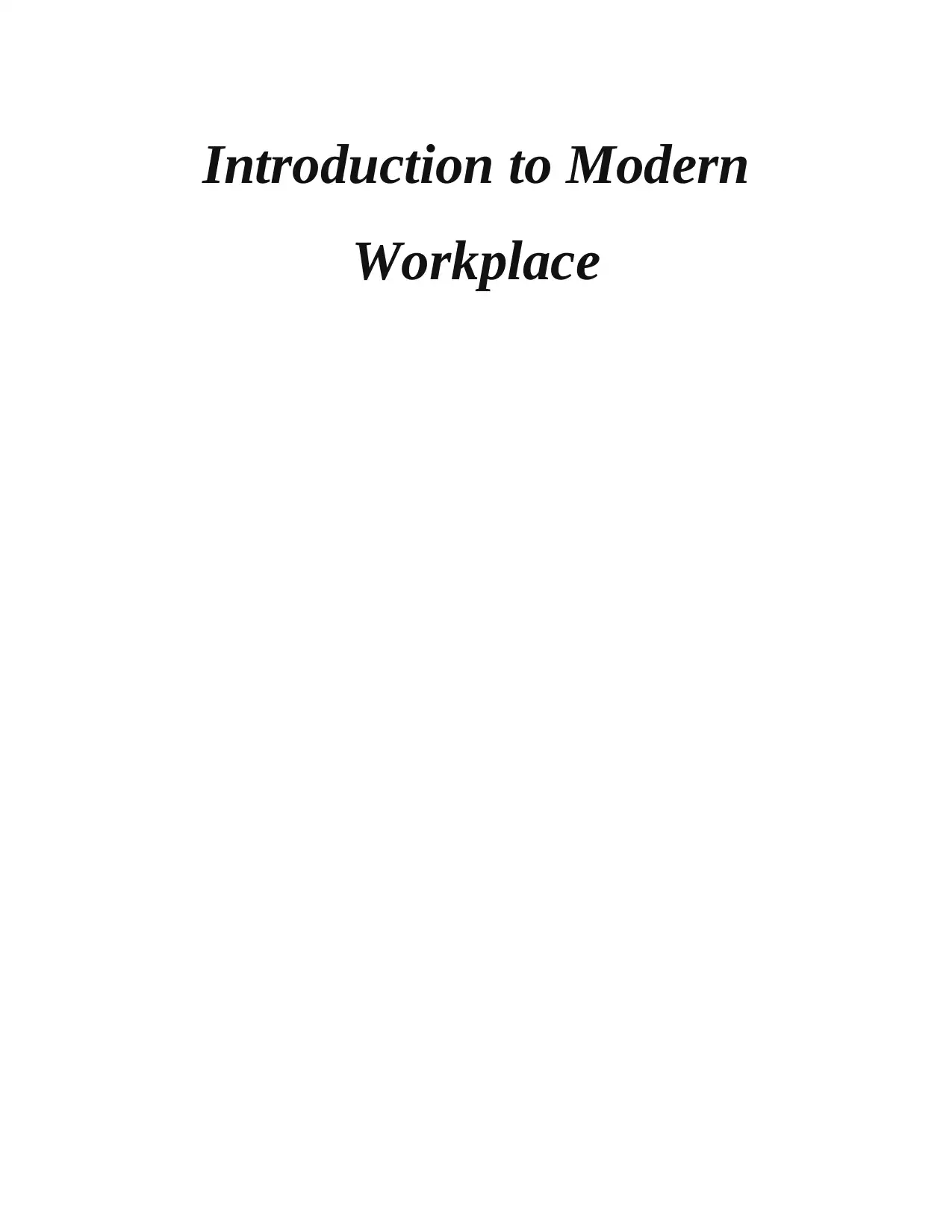
Introduction to Modern
Workplace
Workplace
Paraphrase This Document
Need a fresh take? Get an instant paraphrase of this document with our AI Paraphraser
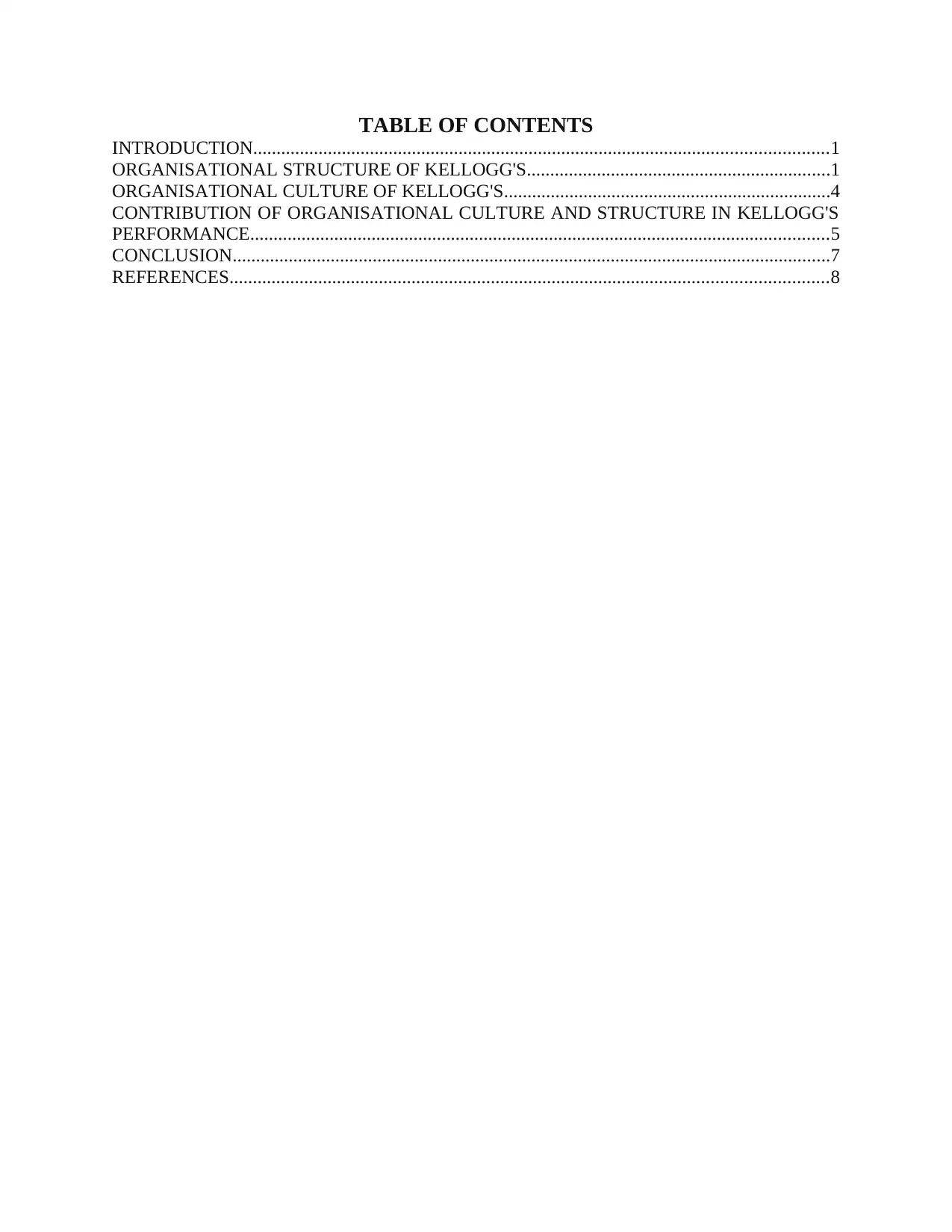
TABLE OF CONTENTS
INTRODUCTION...........................................................................................................................1
ORGANISATIONAL STRUCTURE OF KELLOGG'S.................................................................1
ORGANISATIONAL CULTURE OF KELLOGG'S......................................................................4
CONTRIBUTION OF ORGANISATIONAL CULTURE AND STRUCTURE IN KELLOGG'S
PERFORMANCE............................................................................................................................5
CONCLUSION................................................................................................................................7
REFERENCES................................................................................................................................8
INTRODUCTION...........................................................................................................................1
ORGANISATIONAL STRUCTURE OF KELLOGG'S.................................................................1
ORGANISATIONAL CULTURE OF KELLOGG'S......................................................................4
CONTRIBUTION OF ORGANISATIONAL CULTURE AND STRUCTURE IN KELLOGG'S
PERFORMANCE............................................................................................................................5
CONCLUSION................................................................................................................................7
REFERENCES................................................................................................................................8
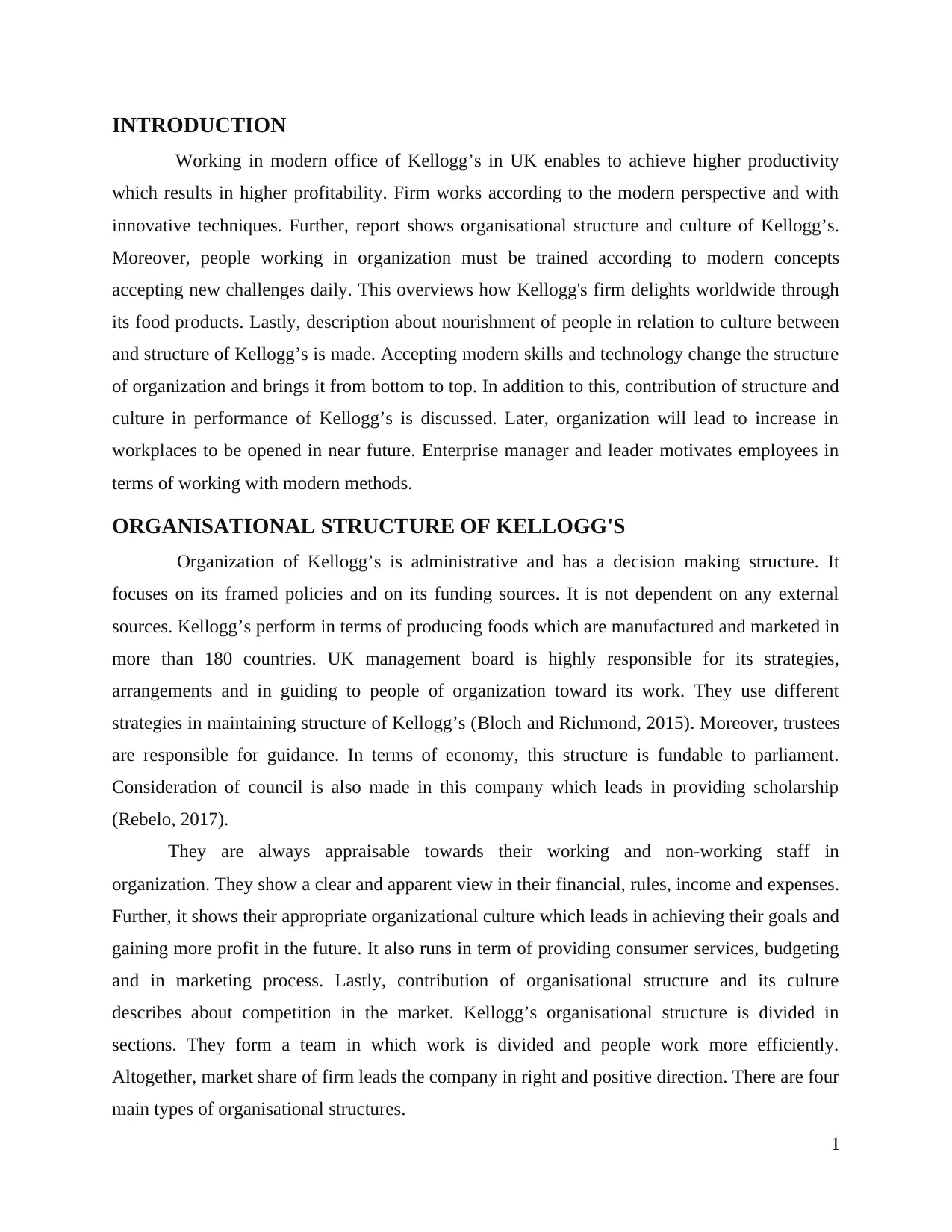
INTRODUCTION
Working in modern office of Kellogg’s in UK enables to achieve higher productivity
which results in higher profitability. Firm works according to the modern perspective and with
innovative techniques. Further, report shows organisational structure and culture of Kellogg’s.
Moreover, people working in organization must be trained according to modern concepts
accepting new challenges daily. This overviews how Kellogg's firm delights worldwide through
its food products. Lastly, description about nourishment of people in relation to culture between
and structure of Kellogg’s is made. Accepting modern skills and technology change the structure
of organization and brings it from bottom to top. In addition to this, contribution of structure and
culture in performance of Kellogg’s is discussed. Later, organization will lead to increase in
workplaces to be opened in near future. Enterprise manager and leader motivates employees in
terms of working with modern methods.
ORGANISATIONAL STRUCTURE OF KELLOGG'S
Organization of Kellogg’s is administrative and has a decision making structure. It
focuses on its framed policies and on its funding sources. It is not dependent on any external
sources. Kellogg’s perform in terms of producing foods which are manufactured and marketed in
more than 180 countries. UK management board is highly responsible for its strategies,
arrangements and in guiding to people of organization toward its work. They use different
strategies in maintaining structure of Kellogg’s (Bloch and Richmond, 2015). Moreover, trustees
are responsible for guidance. In terms of economy, this structure is fundable to parliament.
Consideration of council is also made in this company which leads in providing scholarship
(Rebelo, 2017).
They are always appraisable towards their working and non-working staff in
organization. They show a clear and apparent view in their financial, rules, income and expenses.
Further, it shows their appropriate organizational culture which leads in achieving their goals and
gaining more profit in the future. It also runs in term of providing consumer services, budgeting
and in marketing process. Lastly, contribution of organisational structure and its culture
describes about competition in the market. Kellogg’s organisational structure is divided in
sections. They form a team in which work is divided and people work more efficiently.
Altogether, market share of firm leads the company in right and positive direction. There are four
main types of organisational structures.
1
Working in modern office of Kellogg’s in UK enables to achieve higher productivity
which results in higher profitability. Firm works according to the modern perspective and with
innovative techniques. Further, report shows organisational structure and culture of Kellogg’s.
Moreover, people working in organization must be trained according to modern concepts
accepting new challenges daily. This overviews how Kellogg's firm delights worldwide through
its food products. Lastly, description about nourishment of people in relation to culture between
and structure of Kellogg’s is made. Accepting modern skills and technology change the structure
of organization and brings it from bottom to top. In addition to this, contribution of structure and
culture in performance of Kellogg’s is discussed. Later, organization will lead to increase in
workplaces to be opened in near future. Enterprise manager and leader motivates employees in
terms of working with modern methods.
ORGANISATIONAL STRUCTURE OF KELLOGG'S
Organization of Kellogg’s is administrative and has a decision making structure. It
focuses on its framed policies and on its funding sources. It is not dependent on any external
sources. Kellogg’s perform in terms of producing foods which are manufactured and marketed in
more than 180 countries. UK management board is highly responsible for its strategies,
arrangements and in guiding to people of organization toward its work. They use different
strategies in maintaining structure of Kellogg’s (Bloch and Richmond, 2015). Moreover, trustees
are responsible for guidance. In terms of economy, this structure is fundable to parliament.
Consideration of council is also made in this company which leads in providing scholarship
(Rebelo, 2017).
They are always appraisable towards their working and non-working staff in
organization. They show a clear and apparent view in their financial, rules, income and expenses.
Further, it shows their appropriate organizational culture which leads in achieving their goals and
gaining more profit in the future. It also runs in term of providing consumer services, budgeting
and in marketing process. Lastly, contribution of organisational structure and its culture
describes about competition in the market. Kellogg’s organisational structure is divided in
sections. They form a team in which work is divided and people work more efficiently.
Altogether, market share of firm leads the company in right and positive direction. There are four
main types of organisational structures.
1
⊘ This is a preview!⊘
Do you want full access?
Subscribe today to unlock all pages.

Trusted by 1+ million students worldwide
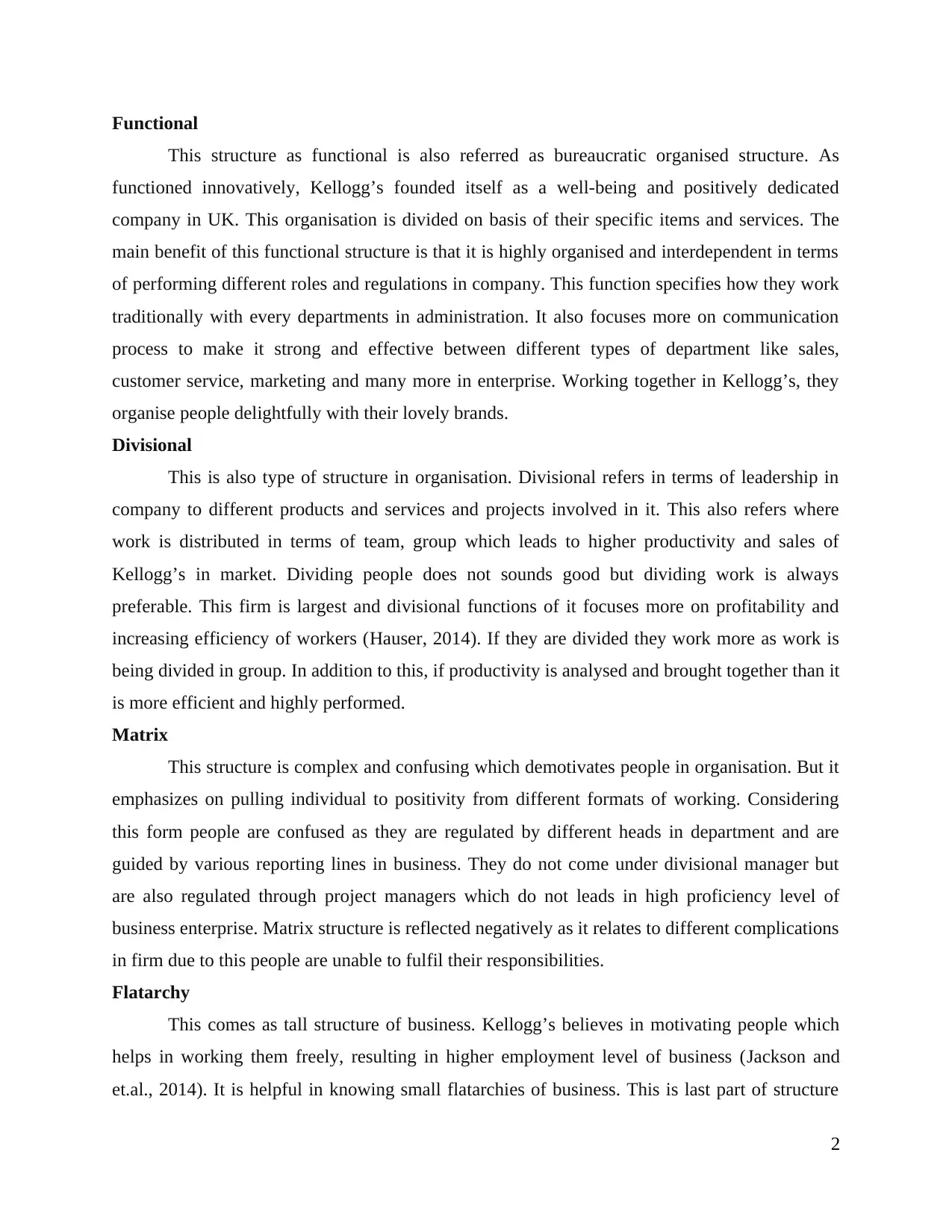
Functional
This structure as functional is also referred as bureaucratic organised structure. As
functioned innovatively, Kellogg’s founded itself as a well-being and positively dedicated
company in UK. This organisation is divided on basis of their specific items and services. The
main benefit of this functional structure is that it is highly organised and interdependent in terms
of performing different roles and regulations in company. This function specifies how they work
traditionally with every departments in administration. It also focuses more on communication
process to make it strong and effective between different types of department like sales,
customer service, marketing and many more in enterprise. Working together in Kellogg’s, they
organise people delightfully with their lovely brands.
Divisional
This is also type of structure in organisation. Divisional refers in terms of leadership in
company to different products and services and projects involved in it. This also refers where
work is distributed in terms of team, group which leads to higher productivity and sales of
Kellogg’s in market. Dividing people does not sounds good but dividing work is always
preferable. This firm is largest and divisional functions of it focuses more on profitability and
increasing efficiency of workers (Hauser, 2014). If they are divided they work more as work is
being divided in group. In addition to this, if productivity is analysed and brought together than it
is more efficient and highly performed.
Matrix
This structure is complex and confusing which demotivates people in organisation. But it
emphasizes on pulling individual to positivity from different formats of working. Considering
this form people are confused as they are regulated by different heads in department and are
guided by various reporting lines in business. They do not come under divisional manager but
are also regulated through project managers which do not leads in high proficiency level of
business enterprise. Matrix structure is reflected negatively as it relates to different complications
in firm due to this people are unable to fulfil their responsibilities.
Flatarchy
This comes as tall structure of business. Kellogg’s believes in motivating people which
helps in working them freely, resulting in higher employment level of business (Jackson and
et.al., 2014). It is helpful in knowing small flatarchies of business. This is last part of structure
2
This structure as functional is also referred as bureaucratic organised structure. As
functioned innovatively, Kellogg’s founded itself as a well-being and positively dedicated
company in UK. This organisation is divided on basis of their specific items and services. The
main benefit of this functional structure is that it is highly organised and interdependent in terms
of performing different roles and regulations in company. This function specifies how they work
traditionally with every departments in administration. It also focuses more on communication
process to make it strong and effective between different types of department like sales,
customer service, marketing and many more in enterprise. Working together in Kellogg’s, they
organise people delightfully with their lovely brands.
Divisional
This is also type of structure in organisation. Divisional refers in terms of leadership in
company to different products and services and projects involved in it. This also refers where
work is distributed in terms of team, group which leads to higher productivity and sales of
Kellogg’s in market. Dividing people does not sounds good but dividing work is always
preferable. This firm is largest and divisional functions of it focuses more on profitability and
increasing efficiency of workers (Hauser, 2014). If they are divided they work more as work is
being divided in group. In addition to this, if productivity is analysed and brought together than it
is more efficient and highly performed.
Matrix
This structure is complex and confusing which demotivates people in organisation. But it
emphasizes on pulling individual to positivity from different formats of working. Considering
this form people are confused as they are regulated by different heads in department and are
guided by various reporting lines in business. They do not come under divisional manager but
are also regulated through project managers which do not leads in high proficiency level of
business enterprise. Matrix structure is reflected negatively as it relates to different complications
in firm due to this people are unable to fulfil their responsibilities.
Flatarchy
This comes as tall structure of business. Kellogg’s believes in motivating people which
helps in working them freely, resulting in higher employment level of business (Jackson and
et.al., 2014). It is helpful in knowing small flatarchies of business. This is last part of structure
2
Paraphrase This Document
Need a fresh take? Get an instant paraphrase of this document with our AI Paraphraser
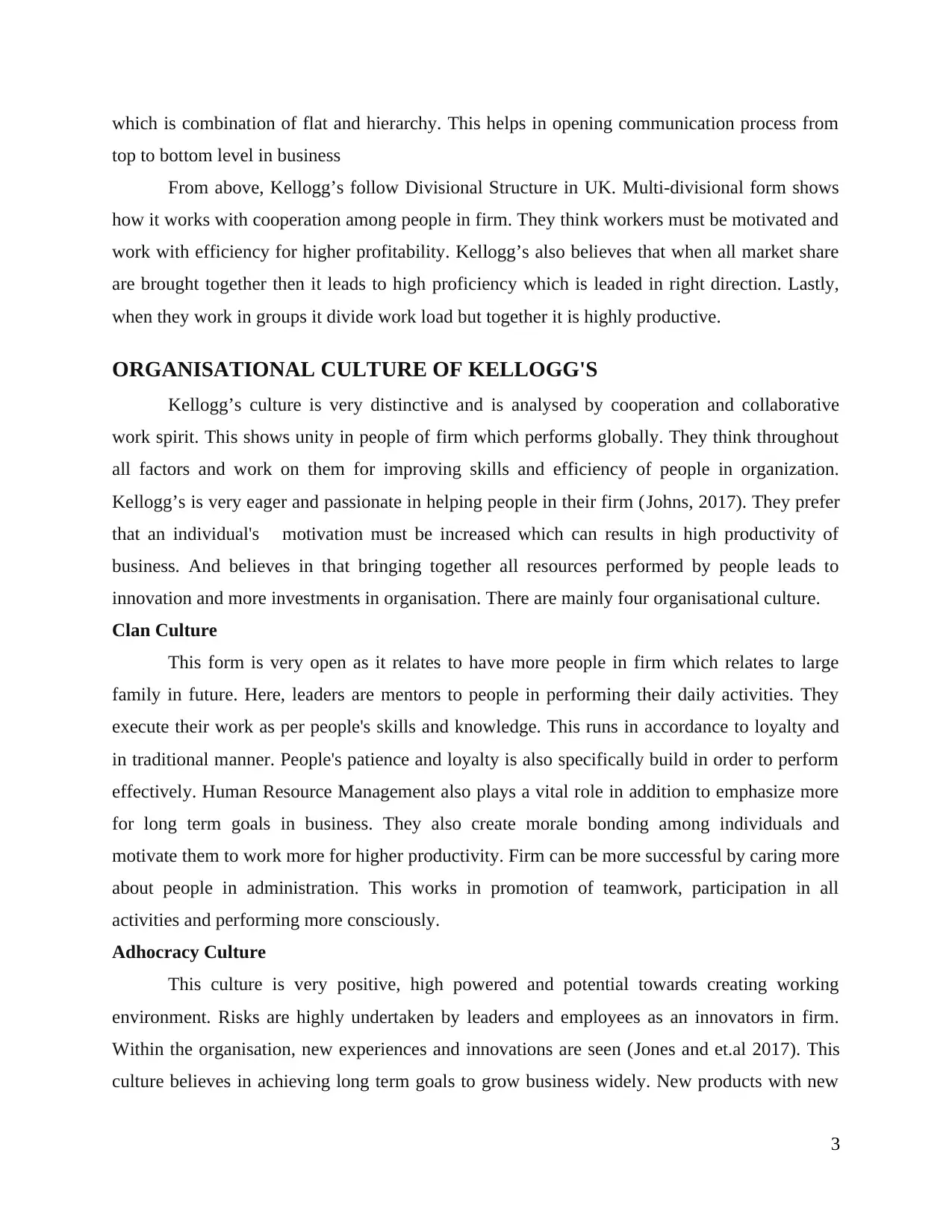
which is combination of flat and hierarchy. This helps in opening communication process from
top to bottom level in business
From above, Kellogg’s follow Divisional Structure in UK. Multi-divisional form shows
how it works with cooperation among people in firm. They think workers must be motivated and
work with efficiency for higher profitability. Kellogg’s also believes that when all market share
are brought together then it leads to high proficiency which is leaded in right direction. Lastly,
when they work in groups it divide work load but together it is highly productive.
ORGANISATIONAL CULTURE OF KELLOGG'S
Kellogg’s culture is very distinctive and is analysed by cooperation and collaborative
work spirit. This shows unity in people of firm which performs globally. They think throughout
all factors and work on them for improving skills and efficiency of people in organization.
Kellogg’s is very eager and passionate in helping people in their firm (Johns, 2017). They prefer
that an individual's motivation must be increased which can results in high productivity of
business. And believes in that bringing together all resources performed by people leads to
innovation and more investments in organisation. There are mainly four organisational culture.
Clan Culture
This form is very open as it relates to have more people in firm which relates to large
family in future. Here, leaders are mentors to people in performing their daily activities. They
execute their work as per people's skills and knowledge. This runs in accordance to loyalty and
in traditional manner. People's patience and loyalty is also specifically build in order to perform
effectively. Human Resource Management also plays a vital role in addition to emphasize more
for long term goals in business. They also create morale bonding among individuals and
motivate them to work more for higher productivity. Firm can be more successful by caring more
about people in administration. This works in promotion of teamwork, participation in all
activities and performing more consciously.
Adhocracy Culture
This culture is very positive, high powered and potential towards creating working
environment. Risks are highly undertaken by leaders and employees as an innovators in firm.
Within the organisation, new experiences and innovations are seen (Jones and et.al 2017). This
culture believes in achieving long term goals to grow business widely. New products with new
3
top to bottom level in business
From above, Kellogg’s follow Divisional Structure in UK. Multi-divisional form shows
how it works with cooperation among people in firm. They think workers must be motivated and
work with efficiency for higher profitability. Kellogg’s also believes that when all market share
are brought together then it leads to high proficiency which is leaded in right direction. Lastly,
when they work in groups it divide work load but together it is highly productive.
ORGANISATIONAL CULTURE OF KELLOGG'S
Kellogg’s culture is very distinctive and is analysed by cooperation and collaborative
work spirit. This shows unity in people of firm which performs globally. They think throughout
all factors and work on them for improving skills and efficiency of people in organization.
Kellogg’s is very eager and passionate in helping people in their firm (Johns, 2017). They prefer
that an individual's motivation must be increased which can results in high productivity of
business. And believes in that bringing together all resources performed by people leads to
innovation and more investments in organisation. There are mainly four organisational culture.
Clan Culture
This form is very open as it relates to have more people in firm which relates to large
family in future. Here, leaders are mentors to people in performing their daily activities. They
execute their work as per people's skills and knowledge. This runs in accordance to loyalty and
in traditional manner. People's patience and loyalty is also specifically build in order to perform
effectively. Human Resource Management also plays a vital role in addition to emphasize more
for long term goals in business. They also create morale bonding among individuals and
motivate them to work more for higher productivity. Firm can be more successful by caring more
about people in administration. This works in promotion of teamwork, participation in all
activities and performing more consciously.
Adhocracy Culture
This culture is very positive, high powered and potential towards creating working
environment. Risks are highly undertaken by leaders and employees as an innovators in firm.
Within the organisation, new experiences and innovations are seen (Jones and et.al 2017). This
culture believes in achieving long term goals to grow business widely. New products with new
3
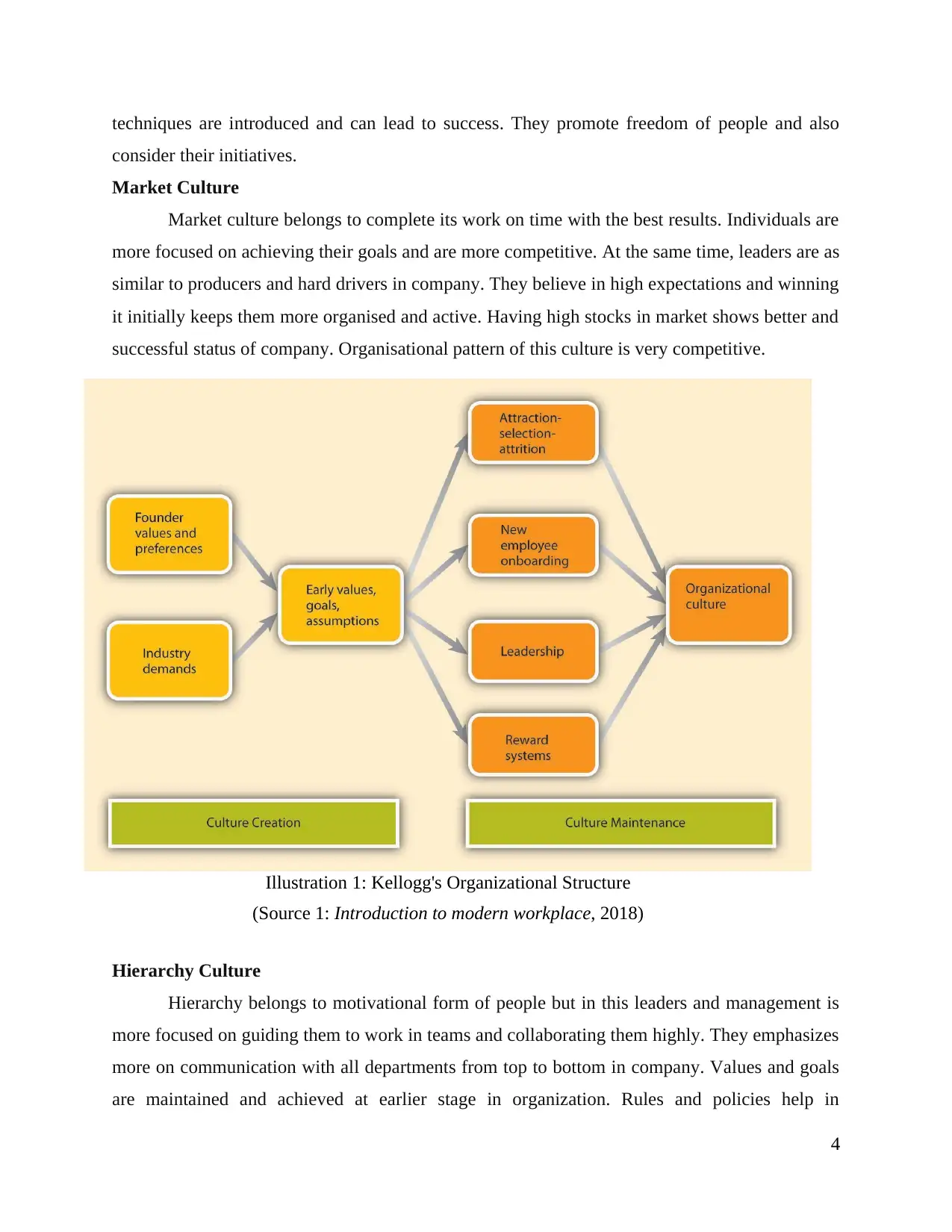
techniques are introduced and can lead to success. They promote freedom of people and also
consider their initiatives.
Market Culture
Market culture belongs to complete its work on time with the best results. Individuals are
more focused on achieving their goals and are more competitive. At the same time, leaders are as
similar to producers and hard drivers in company. They believe in high expectations and winning
it initially keeps them more organised and active. Having high stocks in market shows better and
successful status of company. Organisational pattern of this culture is very competitive.
Hierarchy Culture
Hierarchy belongs to motivational form of people but in this leaders and management is
more focused on guiding them to work in teams and collaborating them highly. They emphasizes
more on communication with all departments from top to bottom in company. Values and goals
are maintained and achieved at earlier stage in organization. Rules and policies help in
4
Illustration 1: Kellogg's Organizational Structure
(Source 1: Introduction to modern workplace, 2018)
consider their initiatives.
Market Culture
Market culture belongs to complete its work on time with the best results. Individuals are
more focused on achieving their goals and are more competitive. At the same time, leaders are as
similar to producers and hard drivers in company. They believe in high expectations and winning
it initially keeps them more organised and active. Having high stocks in market shows better and
successful status of company. Organisational pattern of this culture is very competitive.
Hierarchy Culture
Hierarchy belongs to motivational form of people but in this leaders and management is
more focused on guiding them to work in teams and collaborating them highly. They emphasizes
more on communication with all departments from top to bottom in company. Values and goals
are maintained and achieved at earlier stage in organization. Rules and policies help in
4
Illustration 1: Kellogg's Organizational Structure
(Source 1: Introduction to modern workplace, 2018)
⊘ This is a preview!⊘
Do you want full access?
Subscribe today to unlock all pages.

Trusted by 1+ million students worldwide
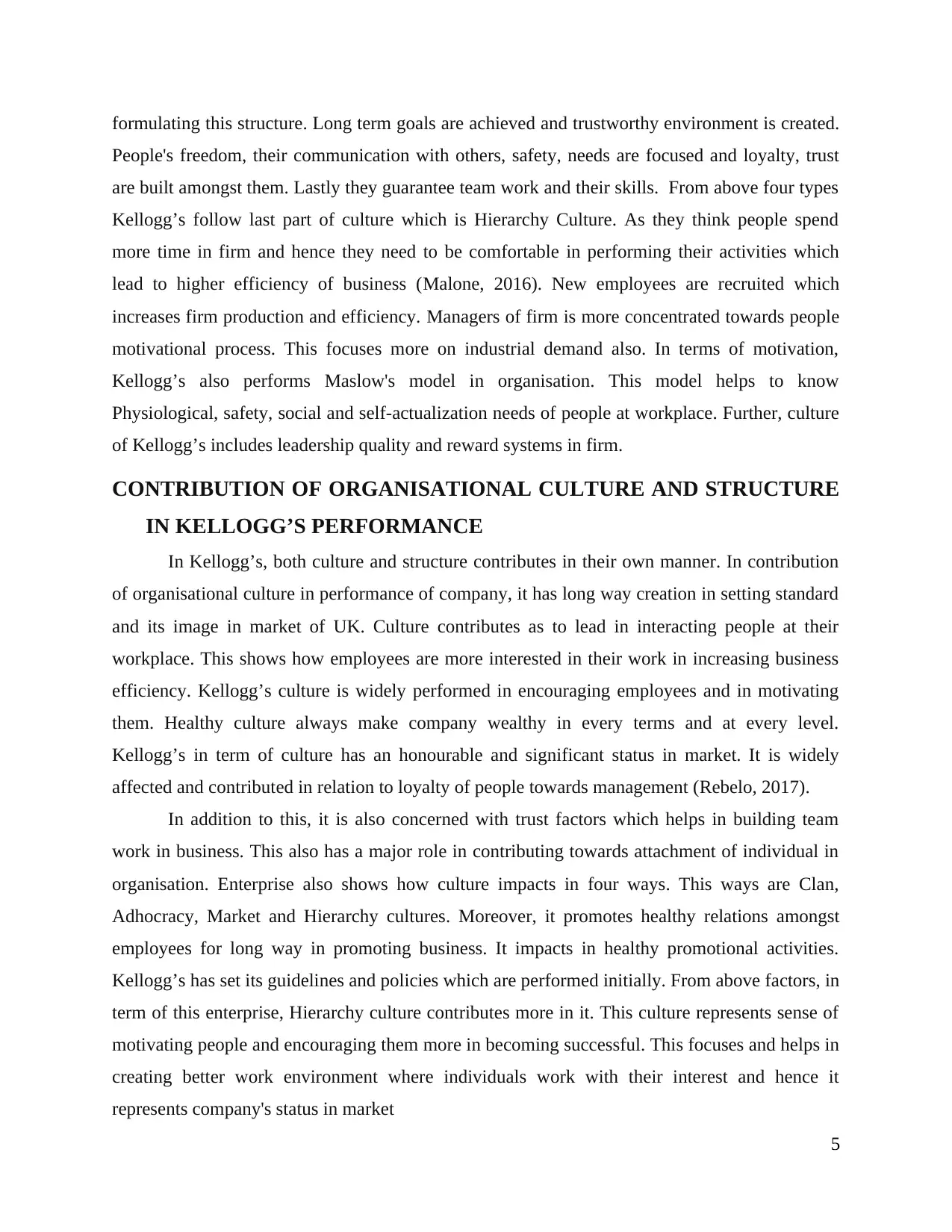
formulating this structure. Long term goals are achieved and trustworthy environment is created.
People's freedom, their communication with others, safety, needs are focused and loyalty, trust
are built amongst them. Lastly they guarantee team work and their skills. From above four types
Kellogg’s follow last part of culture which is Hierarchy Culture. As they think people spend
more time in firm and hence they need to be comfortable in performing their activities which
lead to higher efficiency of business (Malone, 2016). New employees are recruited which
increases firm production and efficiency. Managers of firm is more concentrated towards people
motivational process. This focuses more on industrial demand also. In terms of motivation,
Kellogg’s also performs Maslow's model in organisation. This model helps to know
Physiological, safety, social and self-actualization needs of people at workplace. Further, culture
of Kellogg’s includes leadership quality and reward systems in firm.
CONTRIBUTION OF ORGANISATIONAL CULTURE AND STRUCTURE
IN KELLOGG’S PERFORMANCE
In Kellogg’s, both culture and structure contributes in their own manner. In contribution
of organisational culture in performance of company, it has long way creation in setting standard
and its image in market of UK. Culture contributes as to lead in interacting people at their
workplace. This shows how employees are more interested in their work in increasing business
efficiency. Kellogg’s culture is widely performed in encouraging employees and in motivating
them. Healthy culture always make company wealthy in every terms and at every level.
Kellogg’s in term of culture has an honourable and significant status in market. It is widely
affected and contributed in relation to loyalty of people towards management (Rebelo, 2017).
In addition to this, it is also concerned with trust factors which helps in building team
work in business. This also has a major role in contributing towards attachment of individual in
organisation. Enterprise also shows how culture impacts in four ways. This ways are Clan,
Adhocracy, Market and Hierarchy cultures. Moreover, it promotes healthy relations amongst
employees for long way in promoting business. It impacts in healthy promotional activities.
Kellogg’s has set its guidelines and policies which are performed initially. From above factors, in
term of this enterprise, Hierarchy culture contributes more in it. This culture represents sense of
motivating people and encouraging them more in becoming successful. This focuses and helps in
creating better work environment where individuals work with their interest and hence it
represents company's status in market
5
People's freedom, their communication with others, safety, needs are focused and loyalty, trust
are built amongst them. Lastly they guarantee team work and their skills. From above four types
Kellogg’s follow last part of culture which is Hierarchy Culture. As they think people spend
more time in firm and hence they need to be comfortable in performing their activities which
lead to higher efficiency of business (Malone, 2016). New employees are recruited which
increases firm production and efficiency. Managers of firm is more concentrated towards people
motivational process. This focuses more on industrial demand also. In terms of motivation,
Kellogg’s also performs Maslow's model in organisation. This model helps to know
Physiological, safety, social and self-actualization needs of people at workplace. Further, culture
of Kellogg’s includes leadership quality and reward systems in firm.
CONTRIBUTION OF ORGANISATIONAL CULTURE AND STRUCTURE
IN KELLOGG’S PERFORMANCE
In Kellogg’s, both culture and structure contributes in their own manner. In contribution
of organisational culture in performance of company, it has long way creation in setting standard
and its image in market of UK. Culture contributes as to lead in interacting people at their
workplace. This shows how employees are more interested in their work in increasing business
efficiency. Kellogg’s culture is widely performed in encouraging employees and in motivating
them. Healthy culture always make company wealthy in every terms and at every level.
Kellogg’s in term of culture has an honourable and significant status in market. It is widely
affected and contributed in relation to loyalty of people towards management (Rebelo, 2017).
In addition to this, it is also concerned with trust factors which helps in building team
work in business. This also has a major role in contributing towards attachment of individual in
organisation. Enterprise also shows how culture impacts in four ways. This ways are Clan,
Adhocracy, Market and Hierarchy cultures. Moreover, it promotes healthy relations amongst
employees for long way in promoting business. It impacts in healthy promotional activities.
Kellogg’s has set its guidelines and policies which are performed initially. From above factors, in
term of this enterprise, Hierarchy culture contributes more in it. This culture represents sense of
motivating people and encouraging them more in becoming successful. This focuses and helps in
creating better work environment where individuals work with their interest and hence it
represents company's status in market
5
Paraphrase This Document
Need a fresh take? Get an instant paraphrase of this document with our AI Paraphraser
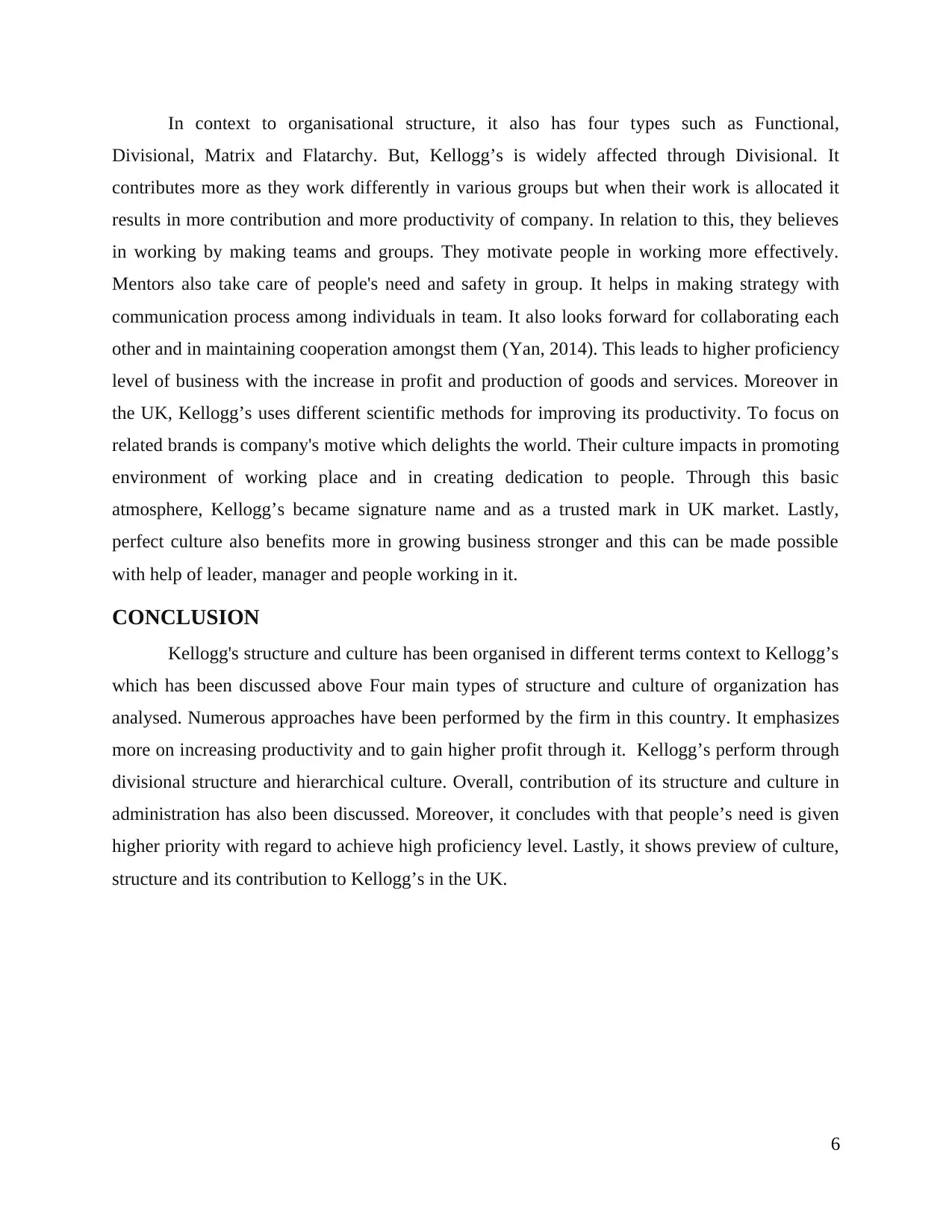
In context to organisational structure, it also has four types such as Functional,
Divisional, Matrix and Flatarchy. But, Kellogg’s is widely affected through Divisional. It
contributes more as they work differently in various groups but when their work is allocated it
results in more contribution and more productivity of company. In relation to this, they believes
in working by making teams and groups. They motivate people in working more effectively.
Mentors also take care of people's need and safety in group. It helps in making strategy with
communication process among individuals in team. It also looks forward for collaborating each
other and in maintaining cooperation amongst them (Yan, 2014). This leads to higher proficiency
level of business with the increase in profit and production of goods and services. Moreover in
the UK, Kellogg’s uses different scientific methods for improving its productivity. To focus on
related brands is company's motive which delights the world. Their culture impacts in promoting
environment of working place and in creating dedication to people. Through this basic
atmosphere, Kellogg’s became signature name and as a trusted mark in UK market. Lastly,
perfect culture also benefits more in growing business stronger and this can be made possible
with help of leader, manager and people working in it.
CONCLUSION
Kellogg's structure and culture has been organised in different terms context to Kellogg’s
which has been discussed above Four main types of structure and culture of organization has
analysed. Numerous approaches have been performed by the firm in this country. It emphasizes
more on increasing productivity and to gain higher profit through it. Kellogg’s perform through
divisional structure and hierarchical culture. Overall, contribution of its structure and culture in
administration has also been discussed. Moreover, it concludes with that people’s need is given
higher priority with regard to achieve high proficiency level. Lastly, it shows preview of culture,
structure and its contribution to Kellogg’s in the UK.
6
Divisional, Matrix and Flatarchy. But, Kellogg’s is widely affected through Divisional. It
contributes more as they work differently in various groups but when their work is allocated it
results in more contribution and more productivity of company. In relation to this, they believes
in working by making teams and groups. They motivate people in working more effectively.
Mentors also take care of people's need and safety in group. It helps in making strategy with
communication process among individuals in team. It also looks forward for collaborating each
other and in maintaining cooperation amongst them (Yan, 2014). This leads to higher proficiency
level of business with the increase in profit and production of goods and services. Moreover in
the UK, Kellogg’s uses different scientific methods for improving its productivity. To focus on
related brands is company's motive which delights the world. Their culture impacts in promoting
environment of working place and in creating dedication to people. Through this basic
atmosphere, Kellogg’s became signature name and as a trusted mark in UK market. Lastly,
perfect culture also benefits more in growing business stronger and this can be made possible
with help of leader, manager and people working in it.
CONCLUSION
Kellogg's structure and culture has been organised in different terms context to Kellogg’s
which has been discussed above Four main types of structure and culture of organization has
analysed. Numerous approaches have been performed by the firm in this country. It emphasizes
more on increasing productivity and to gain higher profit through it. Kellogg’s perform through
divisional structure and hierarchical culture. Overall, contribution of its structure and culture in
administration has also been discussed. Moreover, it concludes with that people’s need is given
higher priority with regard to achieve high proficiency level. Lastly, it shows preview of culture,
structure and its contribution to Kellogg’s in the UK.
6
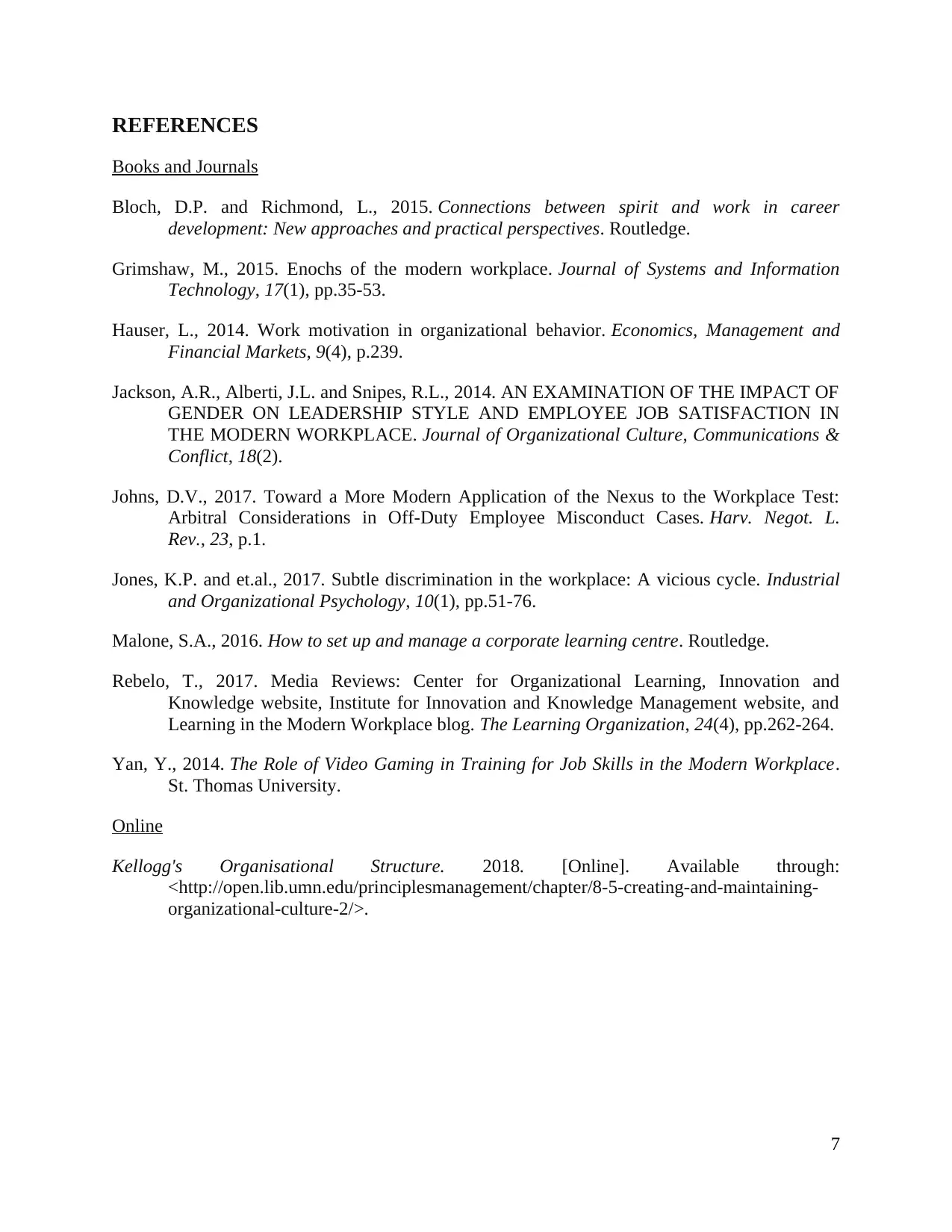
REFERENCES
Books and Journals
Bloch, D.P. and Richmond, L., 2015. Connections between spirit and work in career
development: New approaches and practical perspectives. Routledge.
Grimshaw, M., 2015. Enochs of the modern workplace. Journal of Systems and Information
Technology, 17(1), pp.35-53.
Hauser, L., 2014. Work motivation in organizational behavior. Economics, Management and
Financial Markets, 9(4), p.239.
Jackson, A.R., Alberti, J.L. and Snipes, R.L., 2014. AN EXAMINATION OF THE IMPACT OF
GENDER ON LEADERSHIP STYLE AND EMPLOYEE JOB SATISFACTION IN
THE MODERN WORKPLACE. Journal of Organizational Culture, Communications &
Conflict, 18(2).
Johns, D.V., 2017. Toward a More Modern Application of the Nexus to the Workplace Test:
Arbitral Considerations in Off-Duty Employee Misconduct Cases. Harv. Negot. L.
Rev., 23, p.1.
Jones, K.P. and et.al., 2017. Subtle discrimination in the workplace: A vicious cycle. Industrial
and Organizational Psychology, 10(1), pp.51-76.
Malone, S.A., 2016. How to set up and manage a corporate learning centre. Routledge.
Rebelo, T., 2017. Media Reviews: Center for Organizational Learning, Innovation and
Knowledge website, Institute for Innovation and Knowledge Management website, and
Learning in the Modern Workplace blog. The Learning Organization, 24(4), pp.262-264.
Yan, Y., 2014. The Role of Video Gaming in Training for Job Skills in the Modern Workplace.
St. Thomas University.
Online
Kellogg's Organisational Structure. 2018. [Online]. Available through:
<http://open.lib.umn.edu/principlesmanagement/chapter/8-5-creating-and-maintaining-
organizational-culture-2/>.
7
Books and Journals
Bloch, D.P. and Richmond, L., 2015. Connections between spirit and work in career
development: New approaches and practical perspectives. Routledge.
Grimshaw, M., 2015. Enochs of the modern workplace. Journal of Systems and Information
Technology, 17(1), pp.35-53.
Hauser, L., 2014. Work motivation in organizational behavior. Economics, Management and
Financial Markets, 9(4), p.239.
Jackson, A.R., Alberti, J.L. and Snipes, R.L., 2014. AN EXAMINATION OF THE IMPACT OF
GENDER ON LEADERSHIP STYLE AND EMPLOYEE JOB SATISFACTION IN
THE MODERN WORKPLACE. Journal of Organizational Culture, Communications &
Conflict, 18(2).
Johns, D.V., 2017. Toward a More Modern Application of the Nexus to the Workplace Test:
Arbitral Considerations in Off-Duty Employee Misconduct Cases. Harv. Negot. L.
Rev., 23, p.1.
Jones, K.P. and et.al., 2017. Subtle discrimination in the workplace: A vicious cycle. Industrial
and Organizational Psychology, 10(1), pp.51-76.
Malone, S.A., 2016. How to set up and manage a corporate learning centre. Routledge.
Rebelo, T., 2017. Media Reviews: Center for Organizational Learning, Innovation and
Knowledge website, Institute for Innovation and Knowledge Management website, and
Learning in the Modern Workplace blog. The Learning Organization, 24(4), pp.262-264.
Yan, Y., 2014. The Role of Video Gaming in Training for Job Skills in the Modern Workplace.
St. Thomas University.
Online
Kellogg's Organisational Structure. 2018. [Online]. Available through:
<http://open.lib.umn.edu/principlesmanagement/chapter/8-5-creating-and-maintaining-
organizational-culture-2/>.
7
⊘ This is a preview!⊘
Do you want full access?
Subscribe today to unlock all pages.

Trusted by 1+ million students worldwide
1 out of 9
Related Documents
Your All-in-One AI-Powered Toolkit for Academic Success.
+13062052269
info@desklib.com
Available 24*7 on WhatsApp / Email
![[object Object]](/_next/static/media/star-bottom.7253800d.svg)
Unlock your academic potential
Copyright © 2020–2025 A2Z Services. All Rights Reserved. Developed and managed by ZUCOL.





